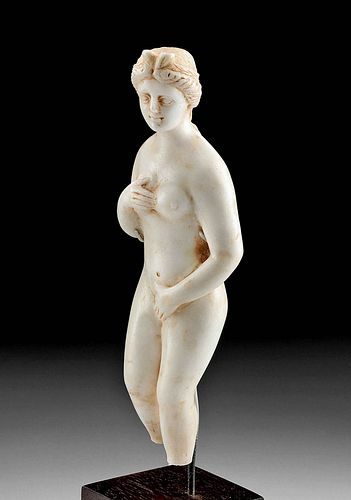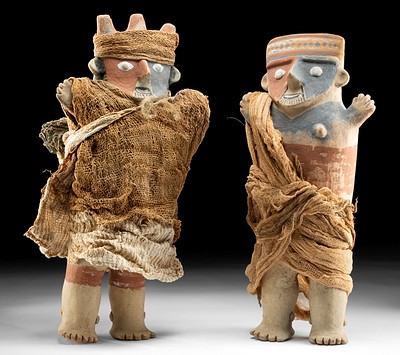Splendid Roman Marble Statuette Nude Venus Pudica
Lot 37a
About Seller
Artemis Gallery
686 S Taylor Ave, Ste 106
Louisville, CO 80027
United States
Selling antiquities, ancient and ethnographic art online since 1993, Artemis Gallery specializes in Classical Antiquities (Egyptian, Greek, Roman, Near Eastern), Asian, Pre-Columbian, African / Tribal / Oceanographic art. Our extensive inventory includes pottery, stone, metal, wood, glass and textil...Read more
Categories
Estimate:
$4,000 - $6,000
Absentee vs Live bid
Two ways to bid:
- Leave a max absentee bid and the platform will bid on your behalf up to your maximum bid during the live auction.
- Bid live during the auction and your bids will be submitted real-time to the auctioneer.
Bid Increments
| Price | Bid Increment |
|---|---|
| $0 | $25 |
| $300 | $50 |
| $1,000 | $100 |
| $2,000 | $250 |
| $5,000 | $500 |
| $10,000 | $1,000 |
| $20,000 | $2,500 |
| $50,000 | $5,000 |
| $100,000 | $10,000 |
| $200,000 | $20,000 |
About Auction
By Artemis Gallery
May 19, 2022
Set Reminder
2022-05-19 10:00:00
2022-05-19 10:00:00
America/New_York
Bidsquare
Bidsquare : Fine Antiquities | Ethnographica | Fine Art
https://www.bidsquare.com/auctions/artemis-gallery/fine-antiquities-ethnographica-fine-art-9350
Featuring a very special collection of Fine Art from the Hollywood Hills, including Picasso & Rookwood ceramics! Also included are many fine examples of classical antiquities, ancient, and ethnographic art from cultures encompassing the globe. Artemis Gallery info@artemisgallery.com
Featuring a very special collection of Fine Art from the Hollywood Hills, including Picasso & Rookwood ceramics! Also included are many fine examples of classical antiquities, ancient, and ethnographic art from cultures encompassing the globe. Artemis Gallery info@artemisgallery.com
- Lot Description
Roman, Imperial Period, ca. 1st to 3rd century CE. What a knockout! Finely carved in the round, a marble sculpture of Venus, the Roman goddess of love, sensitively depicted in the Pudica stance, similar to that of the Capitoline Venus yet with a striking, doe-eyed expression. The graceful deity stands contrapposto with her weight shifted to her left leg and her right knee gently bent as she tenderly turns to her left. Hair centrally parted and pulled back in a low-set chignon, her sweet visage is comprised of huge, amygdaloid eyes with prominent lids, a naturalistic nose, full lips, and a narrow chin, all crowned by a braided headband with a frontal bow. Shown nude, her soft flesh is smoothly rendered, displaying the voluptuous curves of her hourglass figure with shapely thighs, broad hips, and ample breasts. However, the youthful beauty strives to cover herself, holding her right hand over her breast and her left at her pudenda; a pose that simultaneously shields and highlights her bareness. A truly stunning embodiment of the Classical aesthetic! Size: 2.5" W x 7.3" H (6.4 cm x 18.5 cm); 9.6" H (24.4 cm) on included custom stand.
This type of sensuous pose had been favored by earlier Hellenistic sculptors, i.e., Alexandros of Antioch's "Venus de Milo" (130 to 100 BCE) thought to be inspired by Praxiteles' entirely nude the "Aphrodite of Knidos" (ca. 360 to 330 BCE). Indeed, nude or partially nude statues of Venus/Aphrodite made quite a statement in their day (as well as beyond) because they were among the first sculptures to portray a goddess in the nude, a practice that previously had only been reserved for males. Women had been depicted in the nude on earlier Greek pottery paintings; however, those women were typically slave girls or courtesans rather than deities. As an image of a sensual Venus, this example would have been regarded as quite erotic during antiquity. Speaking of the Aphrodite of Knidos for example, Pliny observed that some men were "overcome with love for the statue." Venus/Aphrodite has inspired countless seductive sculptural masterworks throughout art history, among the most famous, Attic sculptor Praxiteles's "Aphrodite of Knidos" (ca. 360 to 330 BCE), "Lely's Venus" (ca. 100 to 199 CE), a Roman copy of a Greek original which is now lost) named for the painter Sir Peter Lily, and Alexandros of Antioch's "Venus de Milo" (130 to 100 BCE).
Cf. Metropolitan Museum of Art, 1995.539.14.
Provenance: private New York, New York, USA collection; ex-private Ohio, USA collection, 1990s
All items legal to buy/sell under U.S. Statute covering cultural patrimony Code 2600, CHAPTER 14, and are guaranteed to be as described or your money back.
A Certificate of Authenticity will accompany all winning bids.
PLEASE NOTE: Due to recent increases of shipments being seized by Australian & German customs (even for items with pre-UNESCO provenance), we will no longer ship most antiquities and ancient Chinese art to Australia & Germany. For categories of items that are acceptable to ship to Australia or Germany, please contact us directly or work with your local customs brokerage firm.
Display stands not described as included/custom in the item description are for photography purposes only and will not be included with the item upon shipping.
#171616Missing both feet. Petite chip to proper left side of nose. Surface wear as shown with some minor nicks to legs, arms, and torso. Otherwise, excellent with impressive preservation of detail and nice earthen deposits in recessed areas.Condition
- Shipping Info
-
All shipping is handled in-house for your convenience. Your invoice from Artemis Gallery will include shipping calculation instructions. If in doubt, please inquire BEFORE bidding for estimated shipping costs for individual items.
-
- Buyer's Premium



 EUR
EUR CAD
CAD AUD
AUD GBP
GBP MXN
MXN HKD
HKD CNY
CNY MYR
MYR SEK
SEK SGD
SGD CHF
CHF THB
THB













